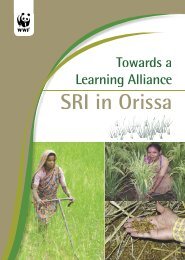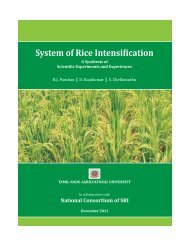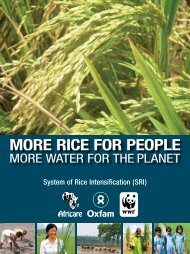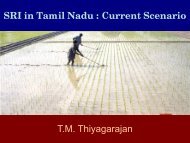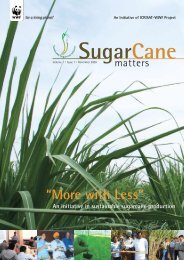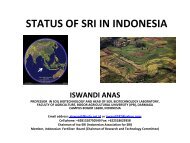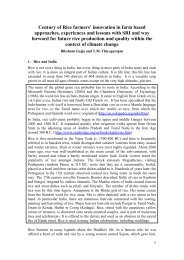Sustainable Sugarcane Initiative (SSI) manual - SRI - India
Sustainable Sugarcane Initiative (SSI) manual - SRI - India
Sustainable Sugarcane Initiative (SSI) manual - SRI - India
You also want an ePaper? Increase the reach of your titles
YUMPU automatically turns print PDFs into web optimized ePapers that Google loves.
Background<br />
Celebrations without sweets and cakes and a cup of coffee or tea without sugar are unthinkable.<br />
Sugar which adds sweetness to our life is extracted from the juice of the sugarcane. The<br />
thick stalks of canes store energy as sucrose in the sap. The cultivation of sugarcane dates back<br />
to the Vedic period. The most ancient reference to sugarcane is in `Athervaveda’ which is 5000<br />
years old, and the word ‘sugar’ is derived from the Sanskrit word Sankkara/Sarkara. In the 1400<br />
- 1500 AD in <strong>India</strong>, cows belonging to the Sultan of Mandu were fed with sugarcane for weeks<br />
to make their milk sweet for use in puddings.<br />
Different species of sugarcane likely originated in different locations with Saccharum barberi<br />
originating in <strong>India</strong> and S. edule and S. officinarum coming from New Guinea. The first sugar<br />
mill in <strong>India</strong> was established in Bengal on the banks of river Hoogly in the year 1784. By 1994 -<br />
1995, <strong>India</strong> had about 408 mills in operation with an average crushing capacity of 2452 tonnes<br />
(t) per day and a crushing duration of 161 days. By March 2005, the total number of sugar<br />
factories in <strong>India</strong> were 571.<br />
<strong>India</strong> ranks second<br />
in the world, after<br />
Brazil, in terms of<br />
area (4.1 m.ha)<br />
and sugarcane<br />
production (355<br />
million tonnes in the<br />
year 2007).<br />
Today, <strong>India</strong> ranks second in the world, after Brazil, in terms of area (4.1 m.ha) and sugarcane<br />
production (355 million tonnes in the year 2007).<br />
In <strong>India</strong>, sugar is a Rs. 30,000 crore industry, the second largest in the country in the agroprocessing<br />
sector, next only to textiles, and represents the principle livelihood of 35 million<br />
farmers. Apart from this, sugarcane is in great demand for various other uses like fodder,<br />
paper production and most importantly bio-fuels. In a typical sugar mill, 100 t of sugarcane<br />
on an average produces 10 t of sugar, 4 t of molasses from which ethanol is produced, 3 t<br />
of press mud which is converted into bio-fertilizer, 30 t of bagasse used for cogeneration of<br />
power to yield 1,500 kw electricity and for manufacturing paper. Besides, about 30 t of cane<br />
tops and leaves are generally left in the field, which through recycling further adds to the<br />
economic value of the crop.<br />
State-wise Area, Production and Productivity of <strong>Sugarcane</strong> in <strong>India</strong> (2006-07)<br />
250<br />
200<br />
150<br />
100<br />
Crystal sugar<br />
There is a growing<br />
demand for sugar<br />
in <strong>India</strong> as it is<br />
the largest sugar<br />
consuming country<br />
in the world (around<br />
20 million tonnes in<br />
the year 2007-08).<br />
50<br />
0<br />
Andhra Pradesh<br />
Assam<br />
Bihar<br />
Gujarat<br />
Haryana<br />
Karnataka<br />
Madhya Pradesh<br />
Maharashtra<br />
Orissa<br />
Punjab<br />
Tamil Nadu<br />
Uttar Pradesh<br />
Uttarakhand<br />
West Bengal<br />
Area (‘0000 ha) Production (MT) Productivity (t/ha)<br />
Source: Directorate of Economics and Statistics, Ministry of Agriculture<br />
Improving <strong>Sugarcane</strong> Cultivation in <strong>India</strong> 7





